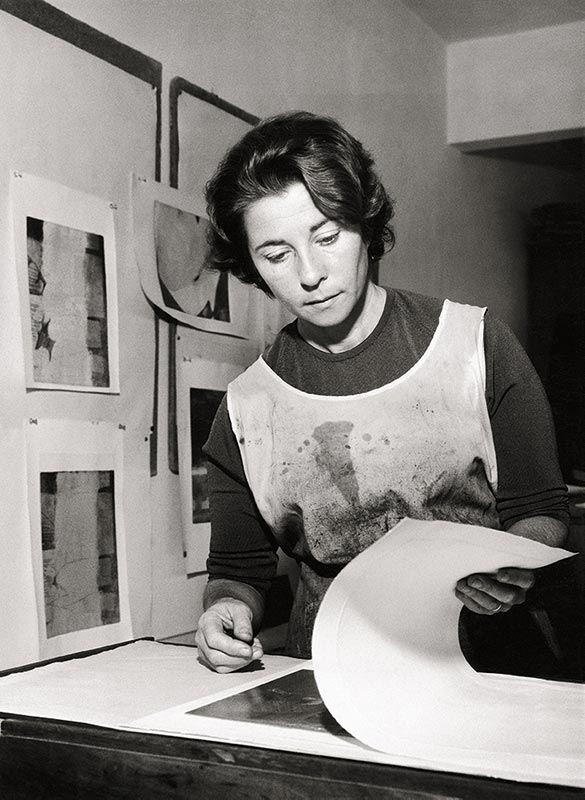68. Fayga Ostrower
| Life Dates | 1920-2001 |
| Place of Birth | Łódź, Poland |
| Place of Death | Rio de Janeiro, Brazil |
| Birth Name | Fayga Krakowski |
Fayga Krakowski was born in Łódź, Poland to a Jewish family who fled to Brazil in 1934 to escape persecution from the Nazis.1 As she worked part-time to help support her family, she also began taking free art classes in 1939 at the Sociedade Brasileira de Belas in Rio de Janeiro. In 1941, she married fellow Polish émigré Heinz Ostrower who was then working at a local bookstore but eventually resumed his political activism for Marxism. By 1946, Ostrower enrolled in graphic arts courses at the Fundação Getulio Vargas, where she studied wood engraving with Axl Leskoschek and metal engraving with Carlos Oswald and Tomás Santa Rosa. Shortly thereafter, Ostrower earned several commissions to execute book illustrations (in linoleum cut), and her reputation grew within Brazil. Her work became increasingly abstract in the 1950s, and in 1955 she earned a Fulbright Scholarship to travel to New York. During this time, she studied graphic arts at the Brooklyn Museum Art School and at Atelier 17 before its closure in September 1955.2 Ostrower also had a solo show of her etchings, aquatints, and woodcuts at The Contemporaries, held May 9 to 28, 1955. After returning to Brazil, Ostrower continued to show her work widely within Latin America, the United States, and Europe.
Archives
Instituto Fayga Ostrower, Rio de Janeiro, Brazil
Selected Bibliography
Barata, Mário, Antônio Bento, Paulo Herkenhoff, Carlos Martins, and Murillo Mendes. Exposição retrospectiva de Fayga Ostrower: obra gráfica, 1944-1983. Rio de Janeiro: Sexante, 1983.
Martins, Carlos, and Wilson Coutinho. Fayga Ostrower. Rio de Janeiro: Sextante, 2001.
Notes
- I wish to thank Silvia Dolinko, Universidad Nacional de San Martin, Buenos Aires, for bringing Ostrower to my attention. I also had the pleasure of meeting Carlos Martins, curator and scholar of Ostrower’s prints, in April 2019 at the University of São Paulo at a symposium sponsored by the Terra Foundation. ↩
- Ostrower was not consistent about her attendance at Atelier 17. In an oral history with Brazilian scholar Maria Teresa Táyora, Ostrower denied she was at Atelier 17. Carlos Martins, however, has uncovered a letter written by Ostrower in 1955 to Jayme Mauricio and published in the Correio da Manhã, in which she states she was working at the Brooklyn Museum Art School and at Atelier 17. In Portuguese, the letter reads: “Estou trabalhando no Brooklyn Museum Art School em artes gráficas e também na técnica de esmaltar metais; fora isso, faço gravuras no Atelier 17, de William Hayter, onde encontrei uma turma bastante boa para trocar impressōes e estimular meu trabalho.” This letter was reprinted in Lilia Sampaio, “Arte, sentido de vida,” in Carlos Martins, Fayga Ostrower (Rio de Janeiro: Sexante, 2001), 166. ↩

